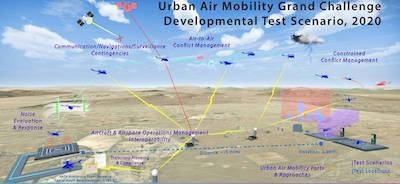Adds 17 Companies To The Urban Air Mobility Effort
NASA has signed Space Act Agreements with 17 companies in the aviation industry to advance plans for the first in a series of technology demonstrations known as the Urban Air Mobility (UAM) Grand Challenge. The goal of the challenge is to test the capabilities and readiness of vehicles and systems that could revolutionize mobility in and around densely populated metropolitan areas.

When fully implemented, UAM will provide a safe and efficient system for passenger and cargo air transportation and could include such innovations as small package delivery within dense urban areas; personal taxi service by air; air medical services, such as patient ambulance transportation; and cargo delivery to underserviced communities.
The NASA-led Grand Challenge series, which these new agreements support, will bring together companies intending to develop and/or operate air vehicles or airspace management services within the larger UAM ecosystem.
“With this step, we’re continuing to put the pieces together that we hope will soon make real the long-anticipated vision of smaller piloted and unpiloted vehicles providing a variety of services around cities and in rural areas,” said Robert Pearce, NASA’s associate administrator for aeronautics.
In addition to bringing together companies involved in emerging air transportation systems, the challenge will help ensure public safety by informing requirements for UAM operations and formalizing best practices to enable the development of regulations by the Federal Aviation Administration.
“Our partnership with the FAA will be a key factor in the successful and safe outcomes for industry that we can expect from conducting these series of Grand Challenges during the coming years,” Pearce said.
While the first Grand Challenge is targeted for 2022, several developmental testing activities are planned for this year. The first step involves activities – known as the Grand Challenge Developmental Testing (GC-DT) – that will lay the groundwork for the first challenge.
“We consider this work as a risk reduction step toward Grand Challenge 1,” said Starr Ginn, NASA’s Grand Challenge lead. “It is designed to allow U.S. developed aircraft and airspace management service providers to essentially try out their systems with real-world operations in simulated environments that we also will be flight testing to gain experience.”
The goal of the developmental test is to assess the readiness of NASA’s test infrastructure while integrating a mobile operating facility and NASA airspace services. The test will verify relevant flight test scenarios, assist in data collection and assess readiness.
So far,17 companies have signed Space Act Agreements with NASA to participate in GC-DT and activities leading up to the first Grand Challenge. With the agreements, which do not involve the exchange of funds, both NASA and the signing parties agree to provide resources to accomplish the goals of the testing.
Selected industry partners provided accepted proposals in one of three categories:
Developmental Flight Testing: Industry partners will provide a vehicle to fly in the GC-DT and demonstrate key integrated operational UAM scenarios as designed by NASA’s UAM Grand Challenge team.
Developmental Airspace Simulation: Industry partners will test its UAM traffic management services in robust NASA-designed airspace simulations in the GC-DT and demonstrate key integrated operational UAM scenarios.
Vehicle Provider Information Exchange: Industry partners and NASA will exchange information with the intent to prepare that partner for possible flight activities during the first Grand Challenge at a NASA-provided or other approved test range in 2022.
The UAM Grand Challenge is managed by the NASA’s Advanced Air Mobility project, a new project office established in the agency’s Aeronautics Research Mission Directorate to coordinate all of NASA’s UAM-related activity as part of its focus to enable emerging aviation markets.
Although the deadline to participate in GC-DT has passed, additional industry partners for the Vehicle Provider Information Exchange activity are welcome and encouraged to submit proposals.
(Infographic provided with NASA news release)
 Airborne 05.10.24: Icon Auction, Drunk MedEvac Pilot, Bell ALFA
Airborne 05.10.24: Icon Auction, Drunk MedEvac Pilot, Bell ALFA ANN's Daily Aero-Term (05.13.24): ILS PRM Approach
ANN's Daily Aero-Term (05.13.24): ILS PRM Approach ANN's Daily Aero-Linx (05.13.24)
ANN's Daily Aero-Linx (05.13.24) Airborne-NextGen 05.07.24: AI-Piloted F-16, AgEagle, 1st 2 WorldView Sats
Airborne-NextGen 05.07.24: AI-Piloted F-16, AgEagle, 1st 2 WorldView Sats Airborne 05.08.24: Denali Update, Dad-Daughter Gyro, Lake SAIB
Airborne 05.08.24: Denali Update, Dad-Daughter Gyro, Lake SAIB



